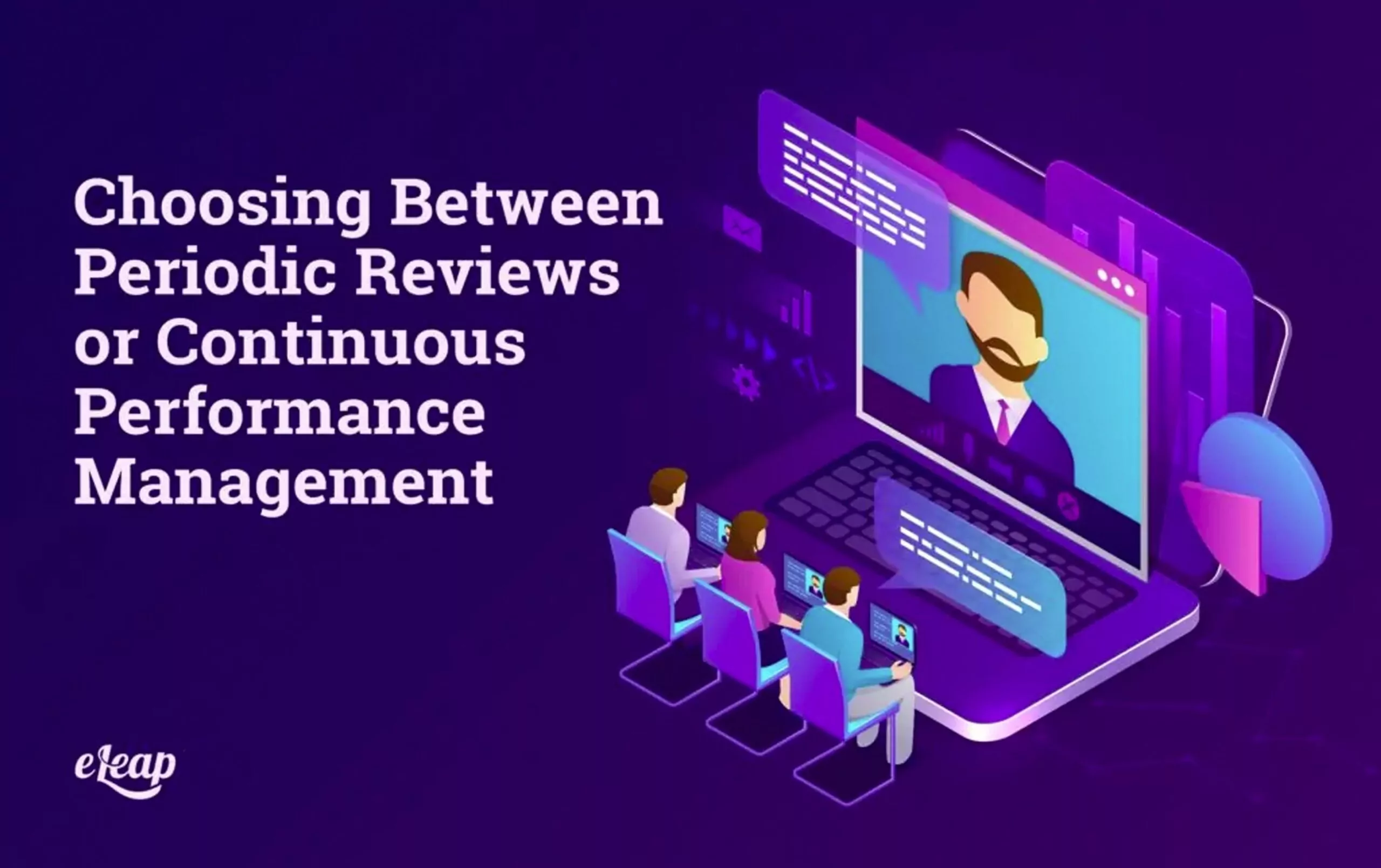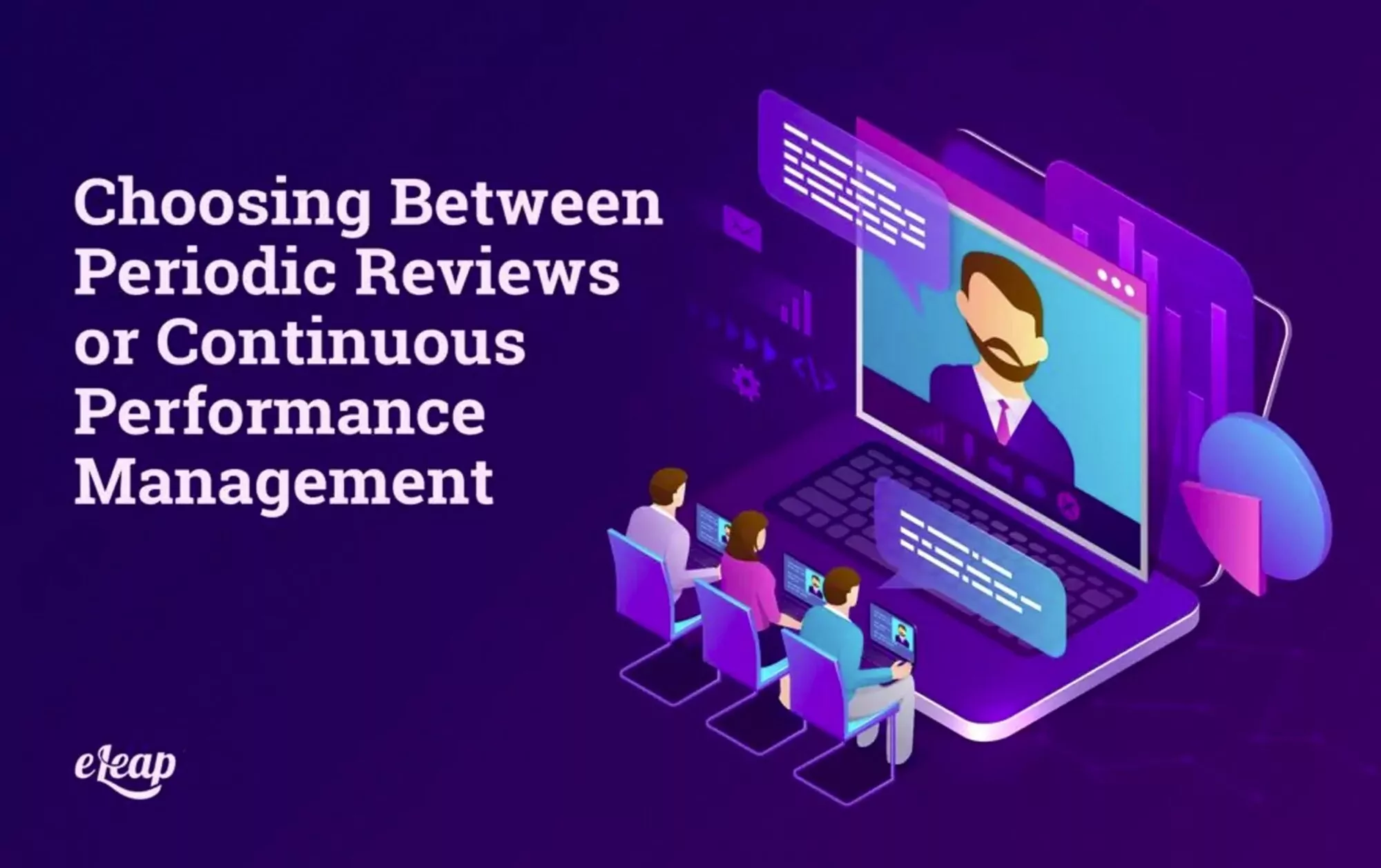Choosing Between Periodic Reviews or Continuous Performance Management

For the last few years, many organizations are moving away from traditional performance management. Instead, it’s becoming more common to choose an alternative to the formal annual performance review. Explore how eLeaP’s Performance Management Platform can simplify evaluations, boost productivity, and drive measurable results.
The typical process of having a manager meet with employees once every year to talk about performance and create goals can be outdated. In addition, it may be far from efficient for the organization.
This is one of the reasons that teams are rethinking the process of performance management. For example, rather than focusing efforts on a once-yearly performance review, many are switching to a continuous feedback system.

What Are Periodic Reviews?
The most common method of performance management is a periodic review. Many employees are used to this system and expect it when moving into a new organization.
A periodic review evaluates the progress of an employee as it relates to established goals. This creates a benchmark for promotion and compensation decisions.
While the frequency of reviews can vary between organizations, a yearly period review is the most common. However, the time between reviews will vary based on the number of employees, how often goals change, how much internal mobility is available, and more.
Disadvantages of Traditional Performance Management
While organizations can get insight about employees from periodic reviews, there are some disadvantages to this kind of system. Some benefits can be seen, but it’s essential to be aware of the cons and how they might affect everyone in an organization.
High Anxiety Levels
Many employees get anxious and stressed around periodic reviews because they carry a considerable amount of weight. Performance is often related to all the most important things to employees, such as job security, pay, confidence in the workplace, and interpersonal relationships.
Even the use of 360 performance reviews, which allow employees to receive feedback from peers, are typically addressed and delivered by only the manager. This creates intense pressure on employees and managers to build a healthy exchange that creates progress without discomfort.
Inaccurate Representation
When both employees and managers are reflecting on a year of work, this can create challenges. Relying on memory can result in forgetting essential details that speak to overall performance. Data-driven goals can track some kinds of employee progress but should also include less quantifiable qualities.
For instance, communication and leadership skills might not be considered even though they offer value to an organization. In addition, with periodic reviews, recency bias is possible. This could be part of why many employees feel as if yearly reviews are unfair.
Less Agility
The employee, team, and organization objectives set the type of performance reviews used. However, goals are constantly changing. For many companies, as the business needs change, goals refresh very quickly.
When a performance review is provided only once a year, it can become misaligned with changing priorities. This might indicate that you should choose a more agile option for performance management. Continuous performance management could be the right choice.
What Makes Continuous Performance Management Different?
It’s becoming more common for an organization to change its traditional performance management system using continuous feedback. The main goal here is to build a culture where it’s normal for managers and employees to delve into honest, ongoing communication.
One thing to keep in mind is that continuous performance management involved both constructive suggestions and praises. These should be received and given across all levels of the organization.
Benefits of Moving Toward Continuous Performance Management
As an organization looking for alternatives to traditional performance management, there are many reasons continuous performance management is the most common choice. Below are a few of the ways it is more valuable than conventional performance management systems.
Focus on Growth of Employees
Rather than focusing only on metrics around performance, ongoing performance feedback creates discussions focused on the development and growth of employees. Having a solid framework to offer regular feedback allows employees to be more active in setting and meeting their goals.
These types of conversations can encourage employees to seek out additional training or other development options. These may not always be related to their specific role but instead provide some kind of value to the organization.
Insights in Real-Time
When a company implements continuous performance management, it removes bias based on what has happened in the near past. Instead, emphasis is placed on suggestions for actions that can be immediately applied.
Instead of waiting months to talk about performance issues, employees and managers can utilize real-time feedback to change goals and correct problems without taking up resources and time until a yearly performance review.
With the advent of new communication technologies, providing immediate feedback has never been easier. As a result, employees can better collaborate and managers have access to timely, accurate insights.
Better Engagement
Employees want to be aware of how they are doing and where they stand. Research shows that 40% of employed Americans would put more effort into work tasks if they were provided with more frequent recognition. This makes continuous performance management an excellent alternative to traditional methods.
When an organization uses real-time feedback for employees, it can create a better experience for employees. In addition, it offers autonomy and transparency, both of which are appreciated by people in the workforce.
As an example, Millennial and Gen Z workers overwhelmingly appreciate timely feedback about their performance. Offering constructive and positive feedback indicates to employees that recognition and development are essential to the organization. This can build a more engaged workforce.
Improved Relationships
Creating a culture with consistent feedback can engage employees, but it goes beyond that. It can also ensure that top talent is retained since they feel as if they have more ownership of their work.
About 60% of employees appreciate recognition even more than a larger salary. In addition, feedback can be valuable for creating better relationships between the business, managers, and employees.
When feedback is provided on a more frequent basis, it feels more authentic and natural for employees. Creating this level of trust is essential when rough patches come up that need everyone to be at their best.
If your company is searching for methods to change its performance management, continuous performance management could be the perfect solution. With so many benefits to employees and managers, it could change the entire culture of your business and make employees willing to go the extra mile.